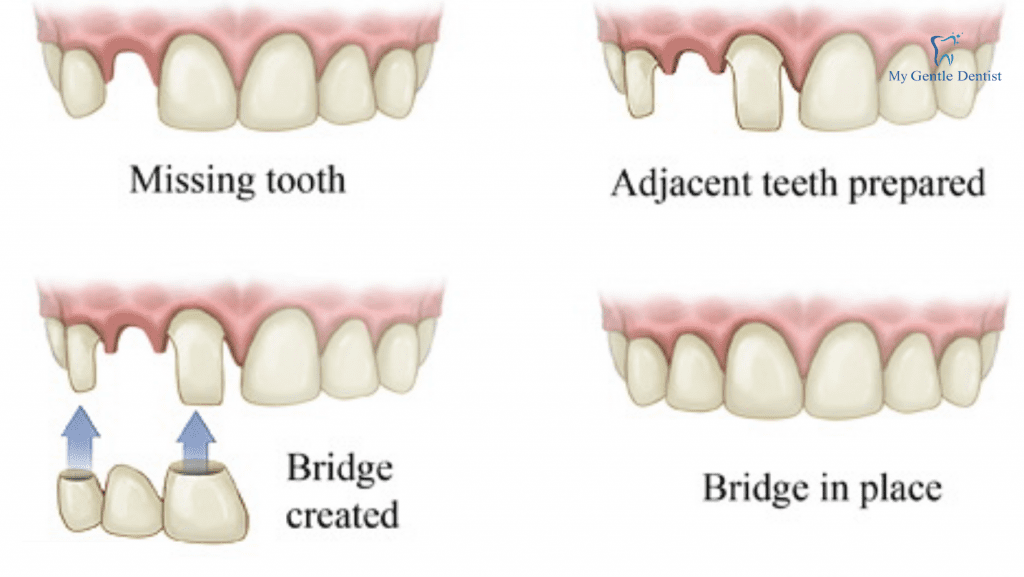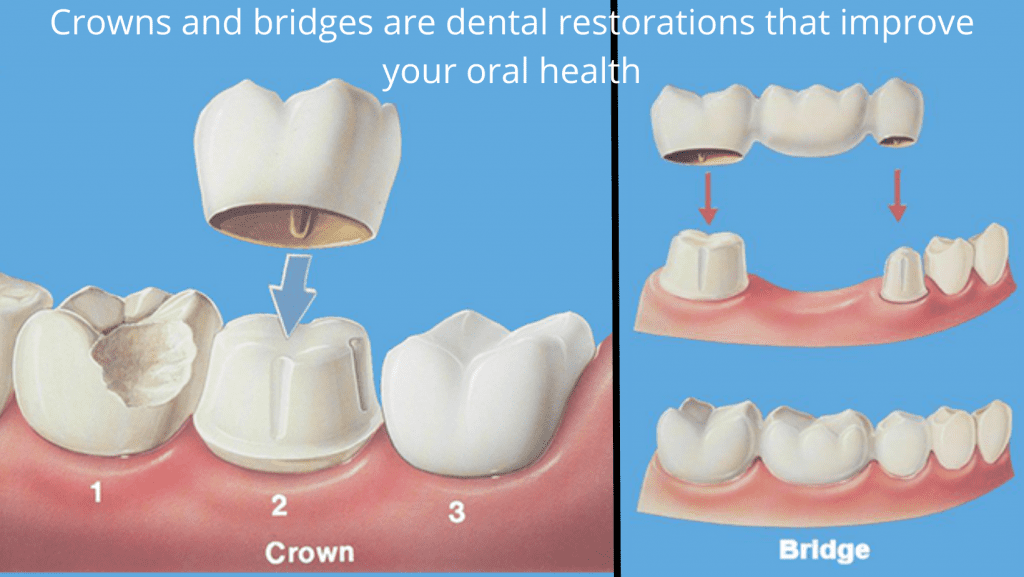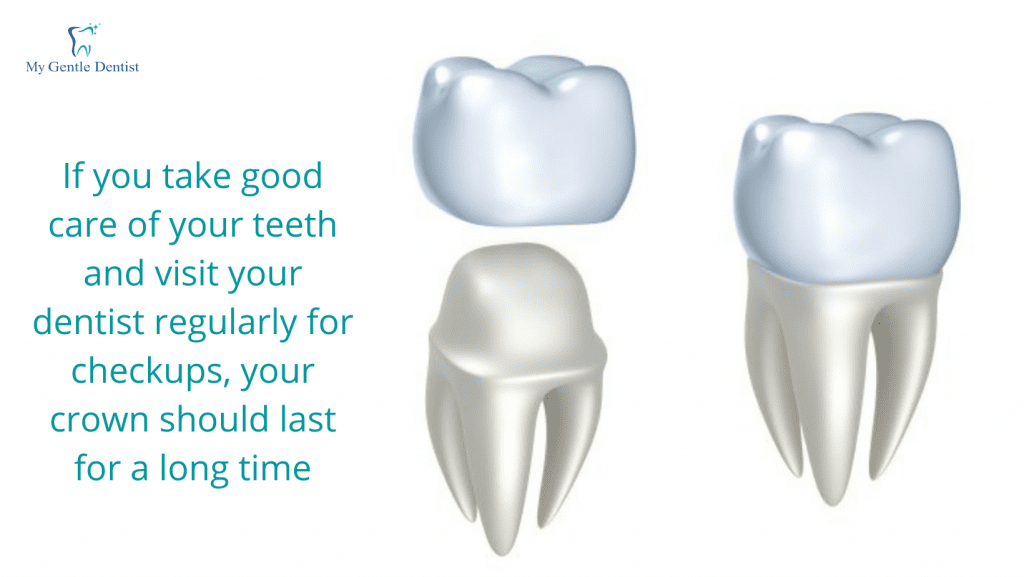If you are in need of dental work, you may have heard of crowns and bridges. But what are they? Crowns are a type of dental restoration that covers the entire surface of a tooth. Bridges are also a type of dental restoration, but they are used to replace missing teeth. In this blog post, we will discuss the differences between crowns and bridges, as well as everything you need to know about them!
What is a Dental Crown?

A dental crown is a type of dental restoration that covers the entire surface of a tooth. Crowns are usually made from porcelain, ceramic, or metal. They are used to restore the function and appearance of teeth that have been damaged by decay, injury, or wear.
If you’re getting a crown to improve the appearance of your smile, then you’ll probably want one made from porcelain or ceramic since they can be color-matched to your natural teeth. The downside to these materials is that they’re not as strong as metal, so if your tooth is in an area of your mouth that gets a lot of wear and tear (like your back molars), then you might be better off with a metal crown.
Crowns are usually placed over existing teeth, but in some cases, they can be used to support a dental bridge. If you’re getting a crown to cover up a tooth that’s been damaged, your dentist will first prepare the tooth by filing it down and then take an impression of it. This impression will be used to create a model of your tooth, which the dental lab will use to create your crown. It usually takes about two weeks to get your crown back from the lab, but in some cases, you can get a same-day crown.
What is a Dental Bridge?

A dental bridge is a type of dental restoration that is used to replace missing teeth. Bridges are usually made from porcelain, ceramic, or metal. They consist of two or more crowns (called abutment crowns) on either side of a gap created by a missing tooth, with a false tooth (or teeth) in between. These false teeth are called pontics, and they can be made from multiple materials such as alloys, porcelain, gold, or a combination of them.
The purpose of a dental bridge is just what its name implies—to bridge the gap created by a missing tooth (or teeth). Bridges are supported by natural teeth or implants. If the bridge is being supported by natural teeth, the abutment crowns will be placed over them. If the bridge is being supported by implants, then the abutment crowns will be placed over the implants.
Like crowns, bridges are usually made in a dental lab and can take two weeks or more to complete. But in some cases, you can get a same-day bridge.
How are dental crowns and bridges placed in your mouth, and what is the process like?

Dental crowns and bridges are usually placed by a dentist or oral surgeon. The procedure is typically performed in an office setting and takes about an hour to complete.
First, the teeth that will support the dental crown or bridge are prepared by being filed down. This is done to make room for the restoration and to ensure that it will fit properly in the mouth.
Next, impressions of the teeth are made. These impressions will be used to create the dental crown or bridge.
Once the restoration is complete, it is placed in the mouth and checked for fit. If everything looks good, the dentist will then bond it to the prepared teeth.
After the procedure is complete, it is important to brush and floss regularly to keep the area clean. Dental crowns and bridges can last for many years with proper care.
What are the benefits of having dental crowns and bridges placed in your mouth, and how will they improve your oral health?

Dental crowns and bridges are two common dental procedures that can improve the function and appearance of your teeth. Crowns are placed over existing teeth to protect them from further damage, while bridges are used to replace missing teeth. Both procedures can help to restore your smile and improve your oral health.
There are many benefits of having dental crowns and bridges placed in your mouth. Crowns can help to strengthen weak or damaged teeth, while bridges can restore the function of missing teeth. Both procedures can also improve the appearance of your smile.
If you are considering dental crowns or bridges, it is important to consult with a qualified dentist to discuss whether they are right for you.
Are there any risks associated with getting dental crowns or bridges placed in your mouth, and what should you watch out for during the treatment process?
There are a few risks associated with dental crowns and bridges, but they are generally rare and can be easily avoided. The most common risk is that the crown or bridge could become loose over time and fall out of your mouth. This is usually due to poor oral hygiene or biting on hard objects. If you take care of your teeth and avoid biting on hard objects, this shouldn’t be a problem.
Another rarer but more serious risk is that the crown or bridge could cause damage to your teeth if it’s not fitted properly. This is why it’s important to see an experienced and reputable dentist for this procedure.
Finally, there is a very small risk of infection associated with any dental procedure. This can usually be avoided by taking antibiotics before and after the procedure.
How much do dental crowns and bridges cost, and is insurance likely to cover the cost of treatment?
Dental crowns and bridges are two common dental procedures that can help restore the function and appearance of your teeth. Both procedures can be expensive, but there are ways to make them more affordable. Additionally, most insurance plans will cover at least a portion of the cost of treatment.
The average cost of a dental crown ranges from $1200 to $2400 per tooth. For bridges, it depends on the number of teeth involved, but you can estimate about the same price as crowns per tooth on the bridge. Most insurance plans will cover at least 50% of the cost of these procedures.
There are several ways to make dental crowns and bridges more affordable. One way is to get them through a dental school or teaching hospital. These facilities typically offer lower rates for dental procedures.
How long do dental crowns last, and how often do you need to get them replaced or repaired?

There is no one definitive answer to this question as it depends on a number of factors, including the type of crown, the materials used, how well you take care of your teeth, and your overall oral health. Generally speaking, however, most dental crowns will last for many years before needing to be replaced or repaired.
If you take good care of your teeth and visit your dentist regularly for checkups, your crown should last for a long time. However, if you do not take care of your teeth well or if you have other oral health problems, your crown may need to be replaced or repaired more frequently.
If you think your dental crown may be damaged or if you have any other concerns, be sure to visit your dentist as soon as possible. They will be able to assess the situation and determine if you need a new crown or if your existing one can be repaired.
Thanks for reading! We hope this article was helpful.
Read More: Dental Crown, Dental Bridge, Dental Crown and Dental Bridge cost, Dental Restoration , Cost of Dental Crown and Dental Bridge Treatment





